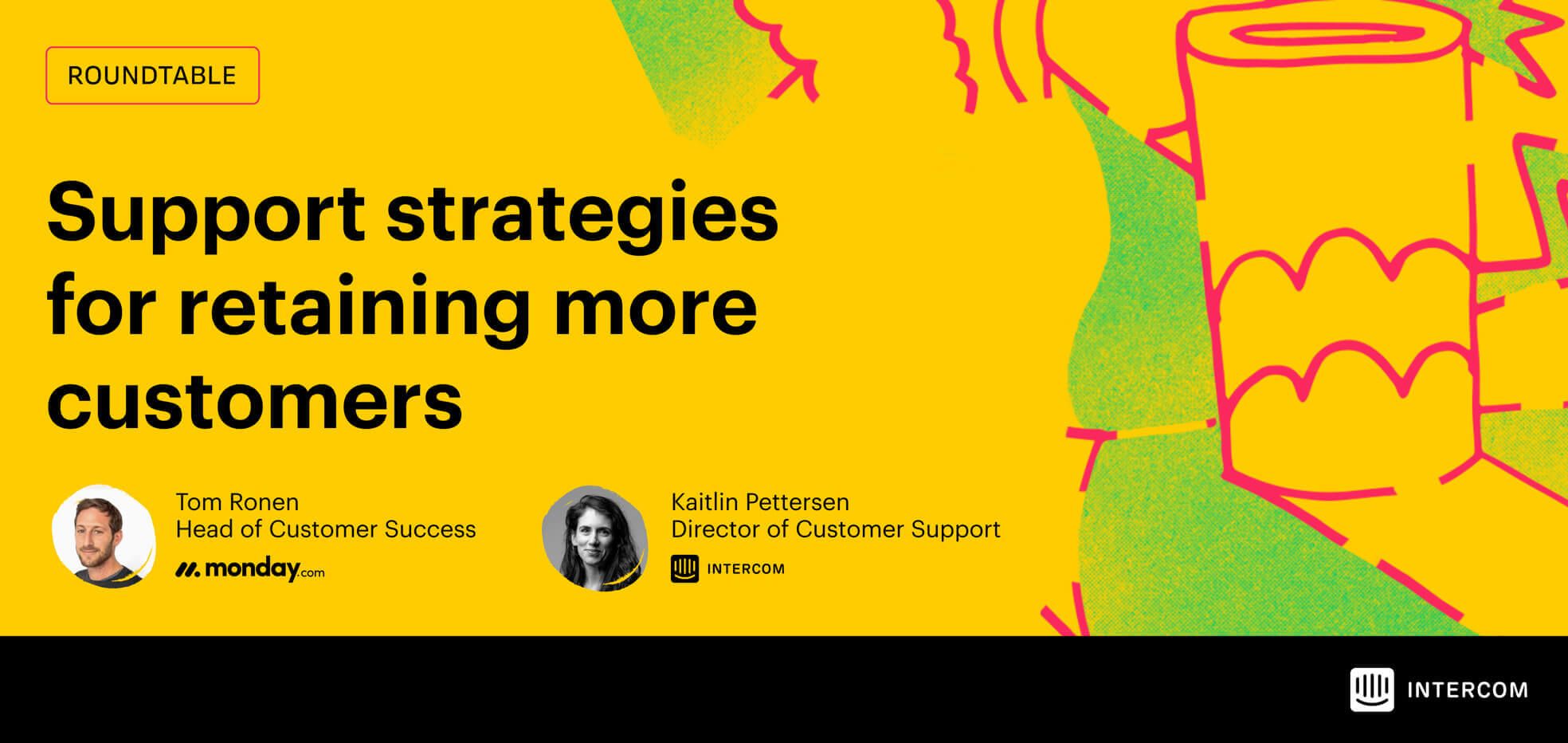
Support strategies that drive better retention
Main illustration: Lily Wang
“We’re seeing a big motion across all businesses on how an amazing customer service experience drives loyalty overall.”
That’s Tom Ronen, Head of Customer Success for monday.com, on a topic that’s been on many of our minds lately: retention. We sat down with Tom and Kaitlin Pettersen, our Senior Director of Customer Support, in a recent webinar that focused on how support teams can increase retention and reduce churn among their customers right now.
The key is in creating a thoughtful, personal, and educational support experience that both increases product satisfaction and deepens product knowledge. But how do you manage immediate customer expectations with your team’s time (and sanity), and keep an open feedback loop with other teams across your organization?
We’ve put together a few key takeaways from the webinar that address the balancing act that support teams have been tasked with to reduce churn among customers.
Reduce customer churn through delightful service and product education
An easy and delightful conversation with support will create confidence that your team and product are here to help them succeed.
1. Enable customers to get the most out of your product through support
The more your support team can help your customers be super users of your product, the more value your customers will be able to get out of it. In order to set customers up for success, teams should do their best to decrease response time when customers reach out, and offer self-serve options so customers can find the information they need on their own.
“The more your support team can help your customers be super users of your product, the more value your customers will be able to get out of it”
For example, Tom’s team at monday.com creates webinars to educate smaller customers who don’t have a dedicated account manager, but who are still important customers to retain.
Leaders should also allow their support team to have longer conversations with customers who have questions about the product. Monday.com, for example, doesn’t measure time to resolution, because Tom wants his team members to take the time they need to equip customers with product knowledge that will help them adapt and customize the product for their needs.
2. Provide a truly delightful experience
Giving customers a positive experience is table stakes for support teams. The entire experience should be pleasant from the moment the customer reaches out to the time the question is resolved.
That means thinking about how to make that experience for them really seamless and cohesive. How can you create systems, workflows, and processes that move conversations from one team to the next in order to keep things effective and efficient for the customer?
This could look like creating a seamless handoff between sales and support. When a member of support has a conversation with a customer where they see the potential for churn or for expansion, they can drive retention by getting that person to the sales team as soon as possible.
3. Tailor your support strategy when working with customers who are about to churn
When a customer cites finances as the reason they can’t use your product anymore, dig a little bit deeper. Does the customer love the product and would come back if they could, but just can’t afford it? Or, are they not getting enough value or seeing ROI?
Then, think about offering specialized support to each of these customers. Can you give the customer who truly can’t afford your product a discount? Can you help the customer who isn’t seeing enough ROI to use your product in a way that will make it worth it for them?
Assist customers in difficult situations with efficiency and flexibility
This is an intense time for many businesses and the types of conversations your team are dealing with are understandably going to be challenging as a result. Here are a few tips for how to help your team navigate through.
1. Provide consistent and fast responses during escalations
Take a step back, pull what data you have on these types of conversations, and see if you can extract some key themes. Then, create one central, useful source of truth that your team can draw on when they tackle an escalation. That will keep things efficient for your customers and your team.
“It’s key, especially as a big team, for us to centralize the workflow, centralize the resources, and keep that updated in real time”
Kaitlin explains, “It’s key, especially as a big team, for us to centralize the workflow, centralize the resources, and keep that updated in real time.”
2. Empower your team to make strategic, spontaneous decisions that can drive retention
At the same time, not every escalation is going to be the same. As a leader, decide what parts of your strategy should come from the top down. And then, in moments where a more personalized touch is needed, hand the decision making power back to your team.
As Tom reflects, “I think the most important thing for us was to give a sense of flexibility for each person on the frontline so that they are really empowered to make changes.” And as your team adapts during those tough conversations, keep the communication lines about how they handled that situation open with the rest of the team, so everyone can learn.
“The most important thing for us was to give a sense of flexibility for each person on the frontline so that they are really empowered to make changes”
Measuring the success of customer retention and churn prevention efforts
Encouraging retention is one thing, but actually tracking it is another. Here’s how you can think about measuring how your team is doing.
Look at your activation metrics, like usage of the platform. For example, if you do a webinar about a set feature and you see an increase of usage in that feature, those behavioral changes can suggest that you’re improving retention as a whole.
Similarly, study how your support conversations and help resources impact feature adoption. Analyze how a customer behaves after talking to support and before talking to support. What is the adoption rate of customers who have been exposed through your help center or to any other help resources? This analysis can help your team understand how your support activities impact metrics that influence retention.
Though an exact retention metric may not sit directly with your support team, you can measure how different support interactions drive better usage of the platform overall.
Work with cross-functional partners to drive retention
Create a feedback loop with other teams and provide data from support interactions that you know will helpful and useful for them. This is especially important for support and product teams. For Tom, that feedback loop “shifts the product and how the product looks and behaves in order to drive retention.”
Support teams can also hand that data to other teams, like marketing, to inform work that could or should be done to get to customers before they even have questions. This can also help teams understand how to surface the right content to the right customer at the right time and place.
Above all, make sure you’re supporting your support team during this time. As Kaitlin puts it, “What we really try to focus in on is creating a sense of flexibility where it’s needed, a sense of normalcy as the world swirls and changes around us, as well as a bit of levity and fun where appropriate.”
Want to watch the full recording? You can see the full webinar here.







